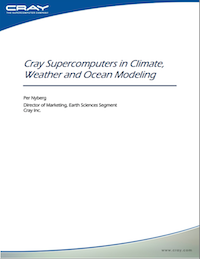
The practical impact of weather, climate and ocean prediction on the world’s population and economy drives the usage of high performance computing (HPC) for earth system modeling. The socioeconomic impacts of improved predictive capabilities are well-recognized by scientists as well as government leaders. The earth’s environment plays an important role in shaping economies and infrastructures, and touches upon nearly every aspect of our daily lives, including recreational activities, food supplies and energy resources.
Cray supercomputers are synonymous with the solution of mission-critical scientific problems and have been systems of choice for many years in the earth system research and operational communities where production capability computing is of strategic importance. Earth system modeling is a key application area that spans nearly the entire spectrum of Cray’s customer base, ranging from those whose core business is earth system modeling to multi-disciplinary HPC centers.
From performance to system and data management, climate, ocean and weather modeling present unique HPC challenges. The computational requirements for simulations of appropriate spatial and temporal scales are immense and require maximum scalability to execute in practical time frames. Cray builds innovative HPC systems that deliver exceptional performance to scientists around the world – from entry-level systems up to the largest and most powerful systems in the world. Cray’s goal is to maximize sustained application performance by combining cost-effective commercial technologies with custom-designed innovations that significantly increase performance, reliability and usability.
This balanced system design approach delivers high-efficiency computing and maintains this efficiency at scale, whether jobs require tens or thousands of processors. The focus on high- efficiency computing allows scientists and forecasters to produce results in the shortest amount of time possible while investigating increasingly complex phenomena. It also allows scientists to solve problems considered difficult to handle on commodity clusters or systems designed for commercial applications. As an example, the Weather Research and Forecasting (WRF) model was used to examine the scalability of a next-generation high-resolution scientific problem on a petascale Cray XT5TM architecture. A record-breaking result of 50 sustained teraflops (trillion floating point operations per second) using 148,480 processing cores was achieved demonstrating that this capability is realizable when combining a scalable system architecture and application design.
All information that you supply is protected by our privacy policy. By submitting your information you agree to our Terms of Use.
* All fields required.



